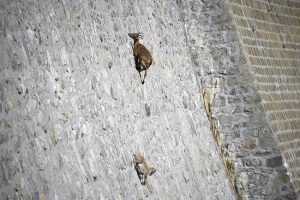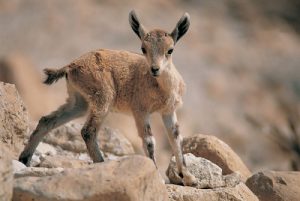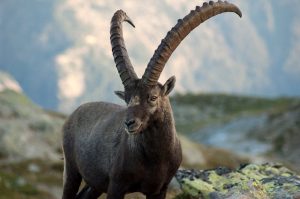Alpine Ibex
Alpine ibex is a wild goat that inhabits the European Alps, occurring at an elevation of 5,900 to 10,800 ft. Although the herbivorous species was extirpated from most of its historical range, it was successfully reintroduced to those regions. All living individuals today are descendants of the stock from Gran Paradiso National Park in Italy and Maurienne valley in France.
Scientific Classification
| Kingdom | Animalia |
| Phylum | Chordata |
| Class | Mammalia |
| Order | Artiodactyla |
| Family | Bovidae |
| Subfamily | Caprinae |
| Tribe | Caprini |
| Genus | Capra |
| Scientific Name | Capra ibex |
Quick Information
| Other Names | Steinbock, Bouquetin |
| Size | Male: 149 to 171 cm Female: 121 to 141 cm |
| Weight | Male: 67 to 117 kg Female: 17 to 32 kg |
| Color | Brownish gray coat with pale abdomen; dark markings on the chin and throat; a stripe along the back |
| Distribution | France, Italy, southern Germany, Switzerland, Austria, Bulgaria, Slovenia |
| Habitat | Steep, rough terrain of the mountains, lowland meadows during spring, alpine meadows during summer and steep rocky slopes during winter |
| Lifespan | 10 to 19 years |
| Diet | Grasses, moss, flowers, leaves, twigs; salt deposits in the rock |
| Adaptations | Long and wooly hair in the winter helps them withstand cold temperature, large lung capacity helps them thrive in high altitudes, strong hooves prevents them from falling down on the mountainous slopes, long and muscular legs aid in jumping and climbing |
| Number of Offspring | Generally one, occasionally two |
| Breeding Season | Late autumn |
| Gestation Period | Around 5 months |
| Predators | Wolves, bears, foxes, lynxes, leopards |
| Conservation Status | Least Concern |
Behavior
Alpine ibexes are social species living in adult male groups, female-offspring groups, mixed sex groups, or young individual groups. They separate sexually depending on the season.
Hierarchy exists in groups among the males which are based on horn size and winners or losers of past conflicts with strangers. Males exhibit antagonistic attitude in the form of direct and indirect aggression. Direct aggression results in one charging another with its horns while the indirect form is a mere display of intimidation.
Mating and Reproduction
The male herds break up into smaller groups searching for females during the breeding season, which lasts for about six weeks. The rut occurs in two stages, during which the males interact with females in estrus. Access to a female depends on the male’s rank in the hierarchy.
In the second stage, one male member leaves his group to follow an individual female. The male displays courtship and protects his mating partner from rivals while the female moves her tail to intensify the courtship. After copulation, the male rejoins his group and reverts to the first stage.
Life Cycle
Shortly after birth, the young ones adapt themselves to the difficult terrain and follow their mother. The male offspring leave their mother’s herd to join bachelor ibexes while the females stay with their mother. The species reach sexual maturity at around eighteen months of age.
Interesting Facts
- In Switzerland, alpine ibex feature on the coat of arms of several communes including the Canton of Grisons, as well as on the logo of Pro Natura.
- By the 18th century, the alpine ibex became extinct in Switzerland and Germany while it became extinct in Austria and northeastern Italy by the 19th century. It remained confined to only in the then Kingdom of Sardinia. Rapid conservative and protective measures helped increase the population of the animal to over 20,000 from 104 in 1976.
- The species is an excellent climber and has been spotted ascending the vertical walls of a dam in northern Italy.
References:
Published on January 14th 2017 by Sajal Datta under Coniferous Forest Animals.
Article was last reviewed on 5th December 2024.











